As a longtime food editor and chief critic at Charleston’s The Post and Courier, Hanna Raskin wasn’t necessarily looking for another plum opportunity.
But when she learned through a colleague about Substack Local, a million-dollar initiative from the newsletter platform to fund a select number of local news publications, she sent a 250-word pitch offhandedly — just one of many emails she fired off that day. Soon, she learned she was one of 12 winners, a position that came with a $70,000 salary in the first year and services like LexisNexis and editing covered by the company. In July 2021, she celebrated her last day at The Post and Courier after almost eight years and her first day at her own independent publication: The Food Section.
“It was not my big idea to leave the paper,” Raskin said. “Much of what I was doing I had pitched within the paper. But they weren’t receptive to it. It didn’t really fit with their business plan, so I made it mine.”
Local newspapers across the United States have been struggling to stay afloat financially for a decade or longer, and independent local news publishers have sprung up in their place. With nimble business models and little baggage to keep them from innovating, these publications are free from many of the constraints that plague traditional media outlets.
But many of these independent local news publishers have found that they are facing fresh issues of their own.
When Raskin started, nobody really knew what Substack was, she said. Now, the name can work against her — some people assume her newsletter is more “musings about noodles” and less hard-hitting news about the food industry in the South. (Raskin announced Monday she would leave Substack, noting that “staying on the platform would ultimately inhibit” the publication’s “growth.”)
Working on a platform with less consumer name recognition also poses a challenge when communicating with sources. Her name, The Food Section, helps in that respect — sources sometimes assume she’s calling from the food section of a local newspaper. They just don’t ask which one.
“With sources, I never say Substack,” Raskin said. “You spend 10 times as much time trying to get your calls returned — and probably only 10% of them are.”
A growing industry
From San Juan to Vancouver, the research is clear: Local independent news outlets are on the rise. A 2021 report from Project Oasis, a collaborative effort charting the progress of local digital news publishers, found 704 digital-native local news outlets in the United States and Canada — a steep increase from a 2010 study that identified only 120 in total.
Membership at LION Publishers, a group for local independent online news publishers, has exploded in recent years. From the end of 2020 to September 2023, LION’s membership grew from 339 to 483 members, said Lisa Heyamoto, the organization’s director of programming for member education.
Heyamoto said 2020 was an inflection point for independent local news publishers, with a “huge jump” in new groups launched. The COVID-19 pandemic was a big motivator behind their start, as was the national racial reckoning that followed the murder of George Floyd, in large part because they exposed the numerous information gaps in local communities.
But these publications aren’t necessarily looking to emulate legacy news publications — at least in scope. Project Oasis’ 2021 study found that more than half of the 255 outlets surveyed made less than $100,000 a year. Only one in 10 brought in more than $1 million. For context, the total circulation revenue of U.S. newspapers in 2022 was around $11.6 billion, per Pew Research Center analysis, while the total advertising dollars hit $9.8 billion.
One of the most significant challenges for independent publishers — as Raskin has found — is marketing an organization that’s doing something completely different.
“There is a trend of more independent news publications launching, particularly in the last three years, to fill a gap in the information needs of their community,” Heyamoto said. “They are trying to meet a different need, and anytime you’re doing a new thing, it’s difficult to explain to people what you’re doing and why they should support you.”
How do you explain an ‘odd bird’ media organization?
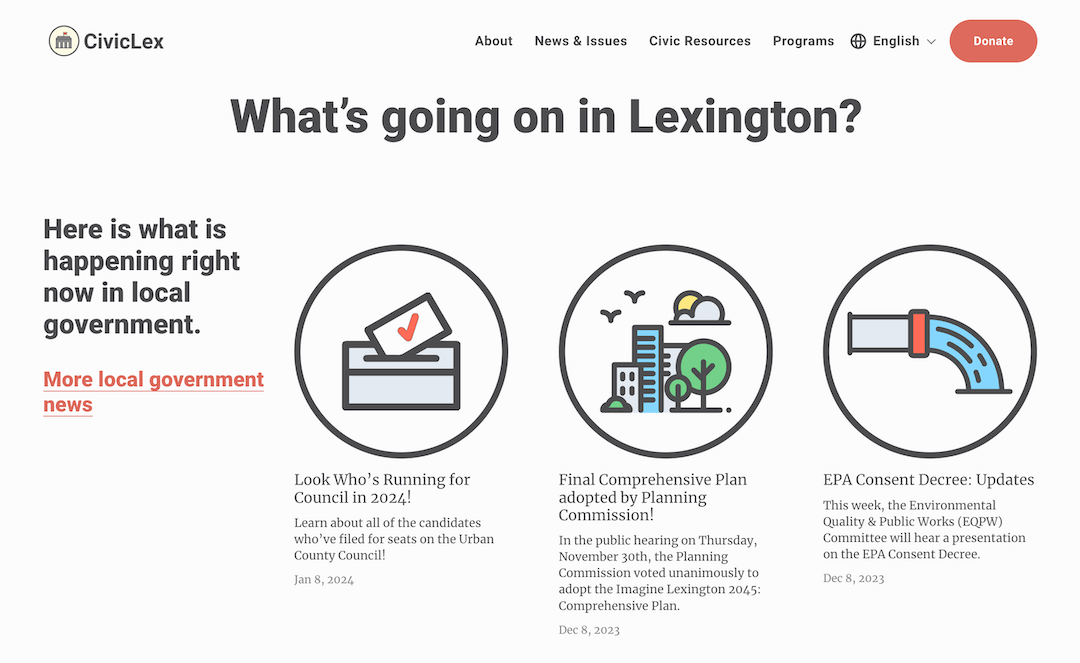
(Screenshot/CivicLex)
Lexington, Kentucky-based nonprofit CivicLex was initially founded to explain to readers how local government actually works.
“In my previous job, I spent a lot of time in city hall,” said Richard Young, a former head of a community development corporation and CivicLex’s founder. “And with some exceptions, it’s the same group of people who show up to a lot of things. They’re great, but they are not reflective of the entire community’s perspective.”
His first thought was: How can we rectify this? How can we get more people to engage? But as CivicLex got off the ground in 2017 and started connecting the average person with government, Young realized there was a bigger problem to tackle — the very ways in which residents could make their voice heard at the local level weren’t easily accessible to the average user and, perhaps more importantly, didn’t have an obvious impact.
“Teaching people how to engage is great. But if that process isn’t good, then people might actually become more disempowered,” Young said. “We had people coming back to us and saying, ‘I don’t think I’m going to get involved in city government again because I’ve had this experience or this experience.’”
So CivicLex leaders began to work directly with Lexington’s local government. It embedded three local artists in the county in a civic artist residency tasked with reimagining the government’s interactions with residents. It reported recommendations for local government leaders on how to improve public input.
“Instead of people leaving (a meeting) and saying, ‘I’m mad I didn’t get what I want,’” Young said, “we want people to leave and say, ‘I didn’t get what I want, but I understand why.’”
CivicLex’s humble beginnings brought challenges. The organization’s first annual budget was $50,000, Young said. The local community foundation helped things along with a multi-year, $100,000 grant, but Young still found it difficult to explain to national funders what CivicLex did. He calls the nonprofit “an odd bird.”
“National folks are like, ‘Are you a local news organization or a civic engagement organization?’ We do all those things,” he said. “It’s hard to wrap their brains around it.”
Now, he said, the majority of the organization’s national funding doesn’t come from the democracy or journalism fields. The nonprofit’s Civic Artist Residency was actually funded through a $75,000 grant from the National Endowment for the Arts, which Young sees as particularly significant.
Almost six years in, he’s less focused on stabilizing CivicLex’s present and more concerned with dreaming big about its future.
“When we hit five years, it just felt like we’d crossed a line,” he said. “What we all talk about here is trying to build a new civic institution in our city, and I think we’re on our way to that. I think we are getting there.”
How do you measure when you meet audiences where they are?
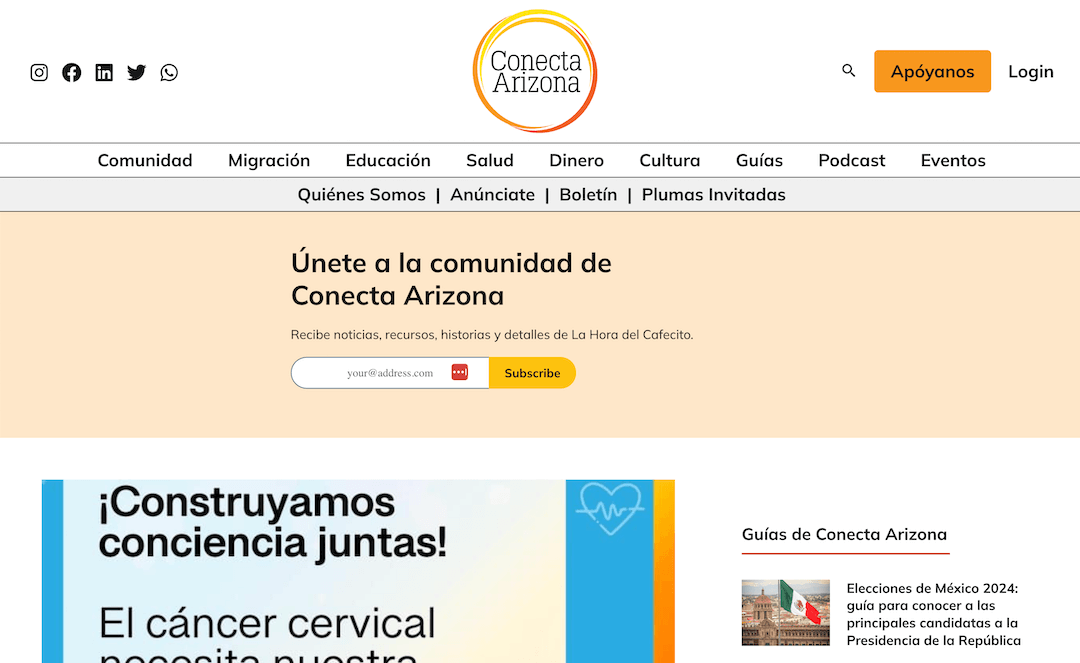
(Screenshot/Conecta Arizona)
At the start of the pandemic, freelance journalist Maritza Félix found herself on the Arizona side of the border with Mexico while her mother was in Sonora, the neighboring state in northwest Mexico. Each morning, they would send each other a greeting. Her mother, who Félix calls “a WhatsApp queen,” crammed her messages with quotes and prayers — everything she could fit. At the end, she would squeeze in the latest information she had read about COVID-19, something that her daughter would then instinctively go to fact-check.
“I was like, ‘I don’t really think baking soda and lemon are going to protect you from coronavirus, but let me check,’” Félix said. “That’s when I decided to create a group to inform my family and close friends about what was happening with COVID. In Arizona, there was nothing in Spanish. Whatever we saw were bad Google translations from the government.”
The informal messages became routine. Recipients expanded beyond Félix’s family and close friends to include what is now an audience of around 4,000 to 5,000 people. Thus, in the spring of 2020, Conecta Arizona was born.
Now, every morning before 9 a.m., Félix sends out a “Ponte al día,” a wake-up message with the headlines of the day and one deep-dive. Then, around 2 p.m., she opens up the group for a chat on everything from Sofia Vergara’s divorce to former President Donald Trump’s indictment to the Mexican presidential race. Once a week, she invites a guest — which has included public health experts and a former ambassador — to respond to questions from the group. In the three years since her launch, she’s also started a call-in radio show, a newsletter and a podcast launched through WhatsApp.
No one is more surprised than Félix at the life that Conecta Arizona has taken on.
“I thought Conecta Arizona was going to last three months, and three years later, we’re still here,” she said. “I thought it was just information about COVID and everything was going to get better. And then, with the elections in 2020, I didn’t prep anything, because I didn’t even think Conecta Arizona was going to be around for 2020. I had to answer more than 500 questions about elections. I wasn’t ready.”
It was also in 2020 that Félix became one of 11 to receive the John S. Knight Community Impact Journalism fellowship at Stanford University. The program awards stipends of up to $70,000, which gave Félix the freedom to focus on Conecta Arizona no longer as an experiment but as a viable news organization. (In 2021, she received a second community impact fellowship from JSK.)
Since then, Conecta Arizona’s work has had real impact, like explaining pandemic-era border restrictions, answering more than 100 questions daily, and beginning the process of getting another Peruvian consulate in Arizona.
But that seed money didn’t solve all of Félix’s problems. The framework of her publication — the brunt of its work exists on social media, outside of its website — brings its own set of challenges. Meta, which owns WhatsApp, is encrypted, meaning that it’s difficult to measure impact in numbers. Conecta Arizona’s WhatsApp podcast doesn’t record the number of listeners. And what is shared on WhatsApp lives solely on the platform.
What Félix does know is this: Conecta Arizona’s WhatsApp group has between 4,000 and 5,000 members. Its radio show has an audience of roughly 55,000 while its newsletter serves 2,000 to 3,000. Combining those sources with media partnerships, Félix estimates that the news organization reaches about 100,000 people.
And while it might be easier to visually demonstrate her work if she switched platforms, Félix is dedicated to WhatsApp because it’s where her audience is. She doesn’t envision Conecta Arizona as a massive media outlet. She wants it to be a place for everyday conversations. And even when funders ask about scaling and how she can expand, she reminds them that endless growth is not the goal.
“After three years, we are finally seeing the light at the end of the tunnel,” Félix said. “We are being invited to apply for things that we weren’t before three years of educating.”
Félix is optimistic about the future. She wants to turn Conecta Arizona’s audience into community storytellers. She hopes to grow in-depth investigations. She believes that the future of journalism is “independent, collaborative and bilingual.”
“For three years, I have not seen myself reflected anywhere. I don’t see any other Latinas with a very thick accent that are immigrants that have red lipstick and are loud like me in leadership positions. It’s very lonely,” she said. “But if I open the door for more Latinas and more languages to be sitting at those tables, that would be amazing.”
How do you run a successful one-person newsroom?
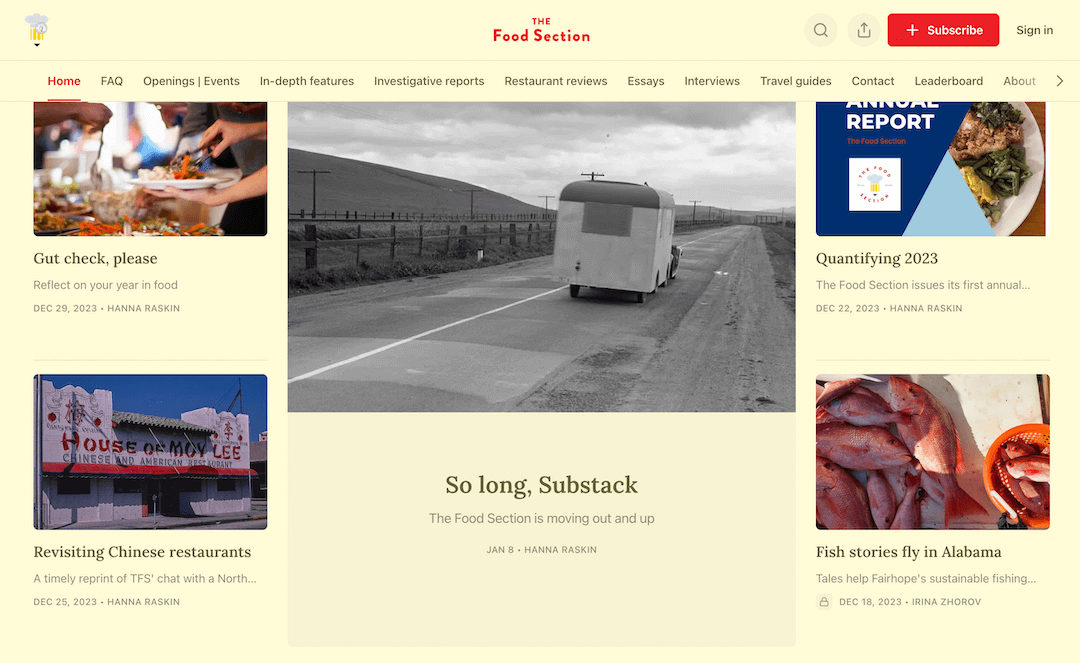
(Screenshot/The Food Section)
With The Food Section, Raskin has been able to build out a comprehensive newsletter that tackles food in a thoughtful way. That ranges from a feature on the North Carolina-based pottery that local restaurants use to an in-depth look at why the behavior of one chef in Birmingham, Alabama, was made ineligible for a James Beard award because of his professional conduct. The latter alone garnered Raskin an additional roughly dozen paid subscriptions.
She has also enlisted freelancers to tell the stories she cannot. In a stirring essay published in March, C., a trans woman incarcerated in a men’s facility in Georgia, recounted her experiences cooking for her fellow prisoners as a way, in large part, to survive.
“That took our readers to a place where many of them have not gone,” Raskin said. “For people who can afford tasting menus and read primarily about food, that is completely new territory for them. That was also where I felt the newsletter was fulfilling its purpose.”
But to continue to fulfill its purpose, the newsletter needs paid subscribers (and, in turn, money). Raskin’s numbers have grown relatively steadily since The Food Section’s inception, hitting 359 at the end of December 2021. By September 2023, at 647, they had almost doubled.
Raskin can thank, in part, an innovative scheme. In May 2022, she had a realization: She was not going to convert most of her current free subscribers to paid subscribers. Instead, she cut a portion of her free subscribers at random. She sent out a warning and urged whoever didn’t want to be cut to subscribe. In the end, the risky strategy paid off — she gained around 50 paid subscribers that month.
She has also learned that revenue cannot come solely from the newsletter. In 2023, she entered into a partnership with North Carolina-based news organization The Assembly, supervising all of their food coverage. Raskin earns about what she did at her newspaper job — she takes roughly $38,000 in revenue from paid subscriptions and $24,000 from her deal with The Assembly. For now, that’s enough. But she worries it won’t always be.
“I’m not looking to get rich, but in order to underwrite the journalism I’m hoping to do, I can’t do that alone,” she said. “I probably can’t do that on $60,000 a year. So there does need to be growth.”
Raskin has a three-pronged plan. She aims to grow partnerships and work with other media organizations on their food coverage. She hopes to build sponsorship and advertising revenue. And she wants to create bureaus in other Southern cities.
Still, there are certain realities Raskin must always grapple with, chief among them that she is but one person running her own media organization. Not only is it lonely being a staff of one, but the act of selling a product doesn’t exactly come naturally to the average journalist. (Though, in December, Raskin announced that The Food Section would add three local sections — in Nashville, Baton Rouge and West Virginia — and onboard a bureau chief for each.)
“It’s always a constant struggle each day: how much time am I going to spend making a publication that folks want to sponsor and how much time am I going to spend seeking sponsorship?” she said. “It is stunning how much work you take on when you are a one-person newsroom.”
Independent publishing represents a catch-22
The challenge for all three of these organizations, Heyamoto said, is the catch-22 of their mission: Their intended audience is not necessarily equipped to provide the financial support they need.
“What we’ve found is that folks who have launched a news organization to serve a community of color — that community gets what they’re doing right away,” she said. “But finding ways to monetize that support can be tricky.”
Reader revenue is vital but also cannot necessarily be enough on its own, Heyamoto said. Diverse revenue streams are key, whether that’s through sponsorships, advertisements or even partnerships, like Raskin’s with The Assembly.
“People are starting to see information in communities as a vital part of the health of those communities,” Heyamoto said. “Our members are trying to make the case to these community foundations for this thing that they have never done before. It’s not just making the case for their particular organization, but the vital need to fund information.”
The key, Heyamoto noted, is changing how we think about news — not as a privilege accessible only to those who can afford it, but as a public service, a necessity intrinsic to the very fabric of our society.


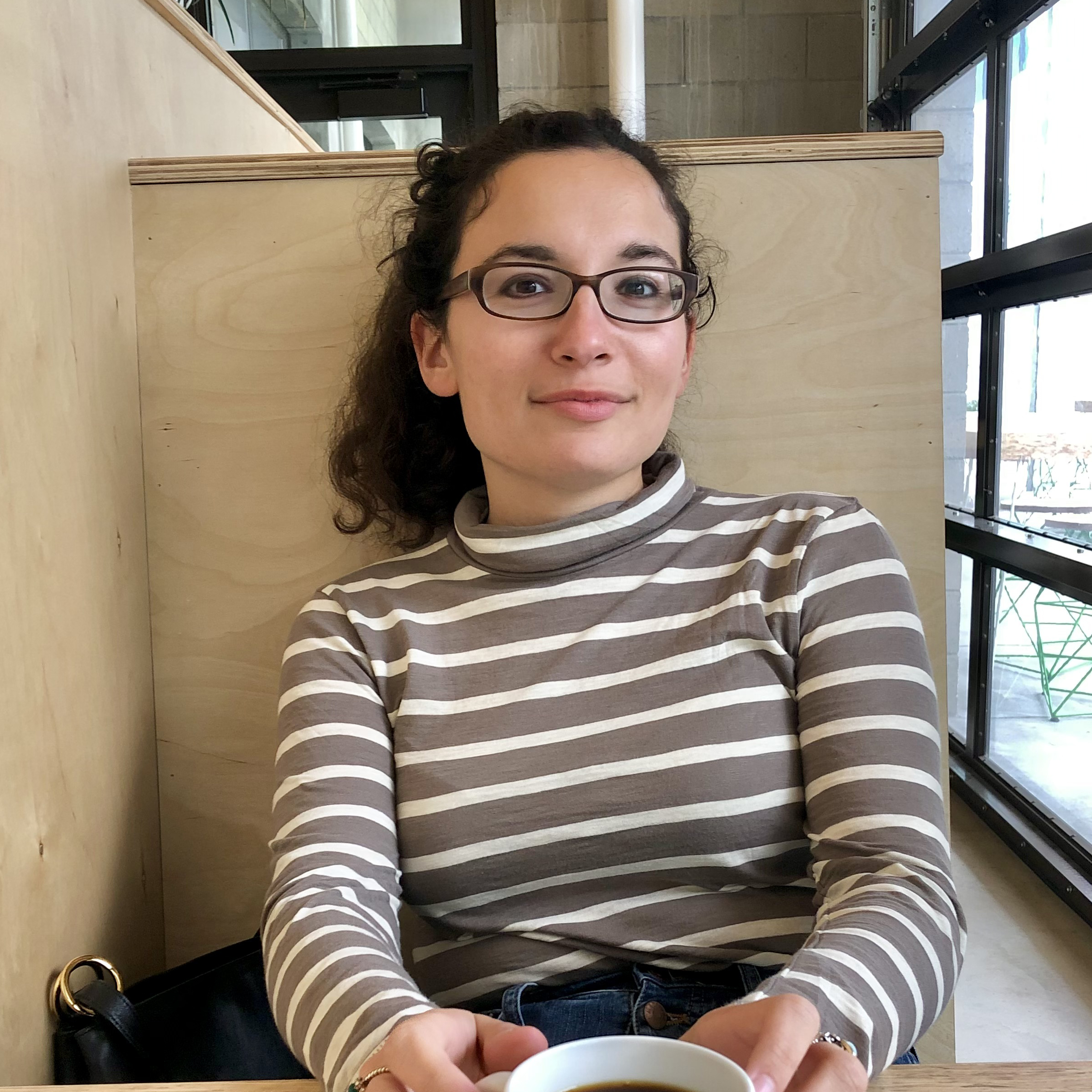
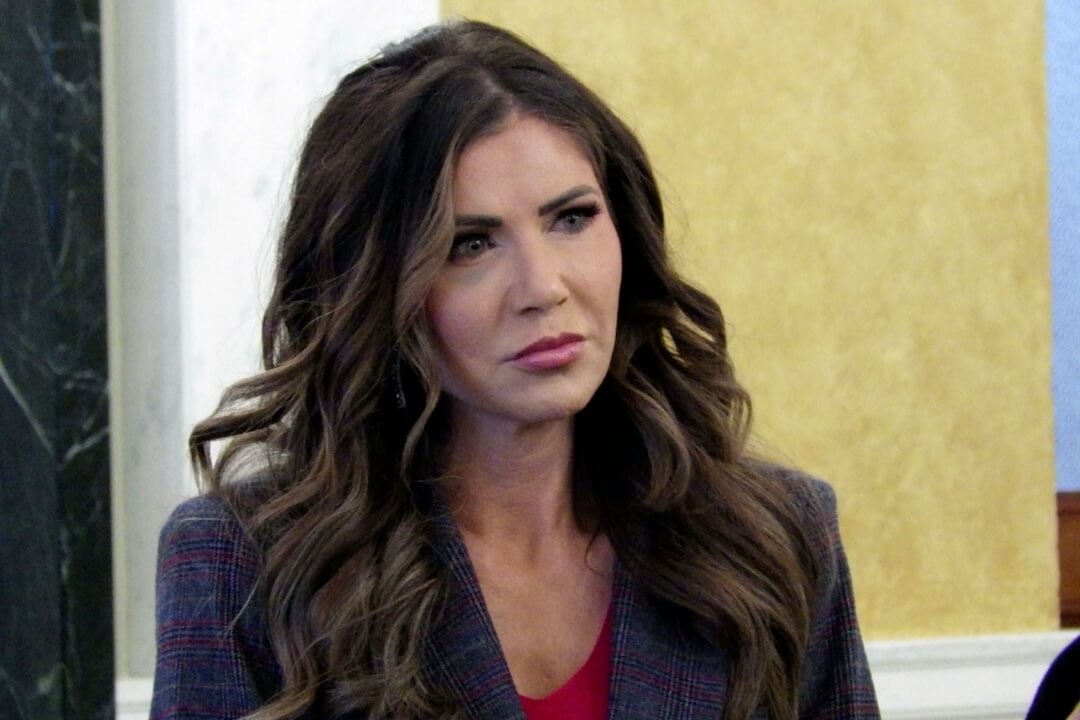

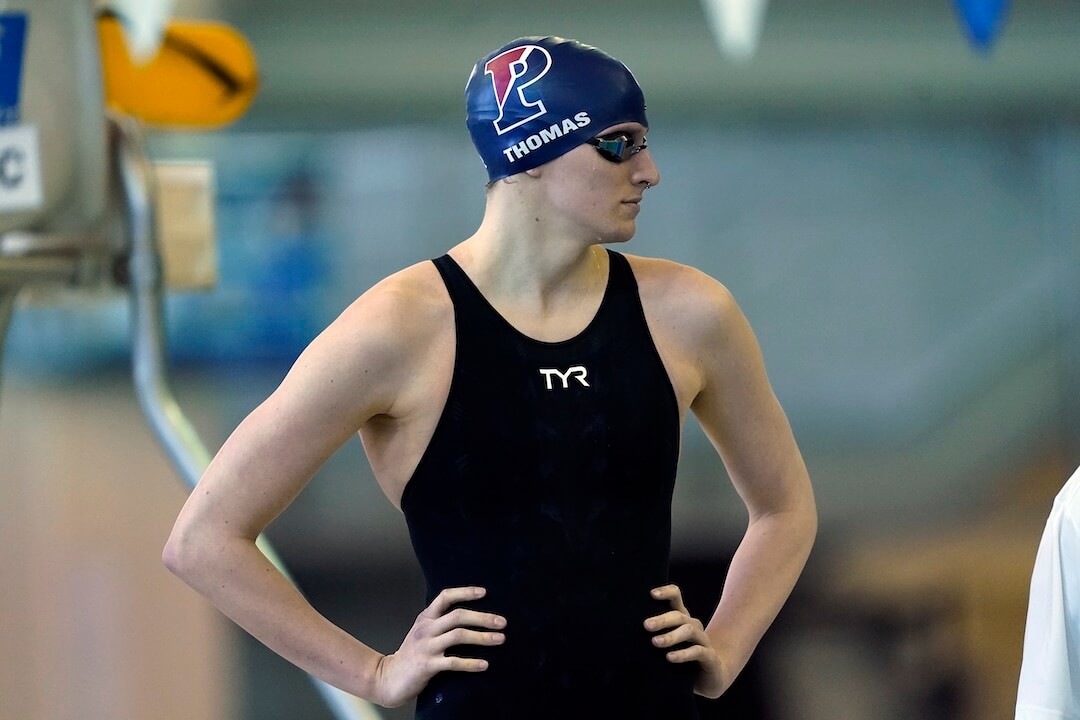
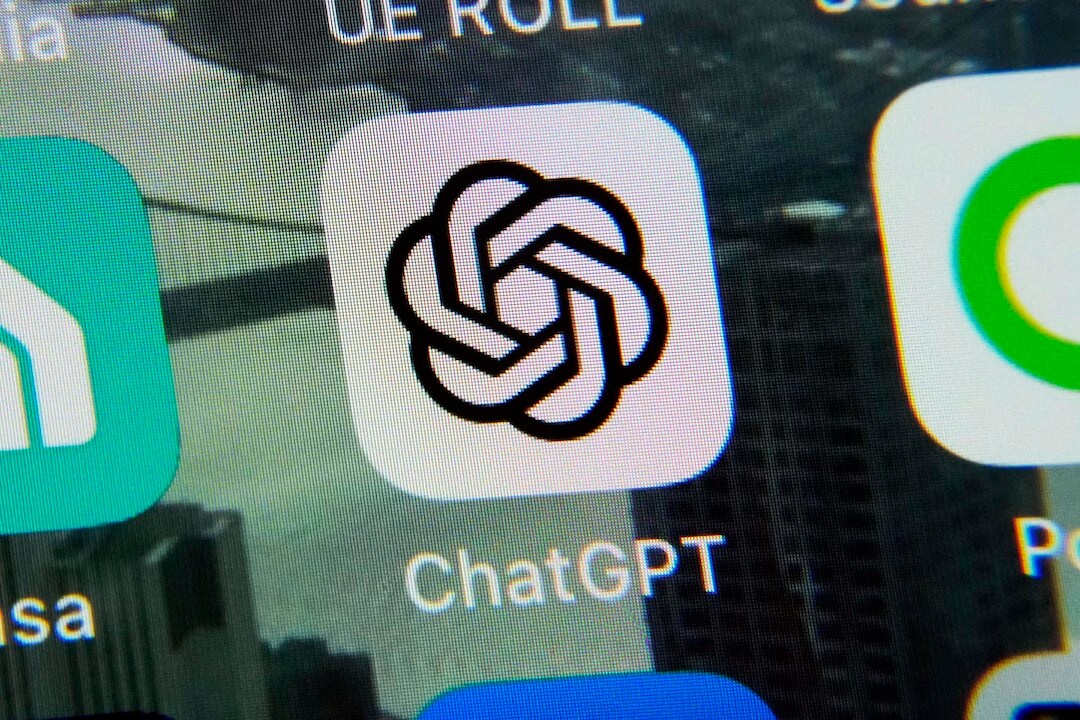
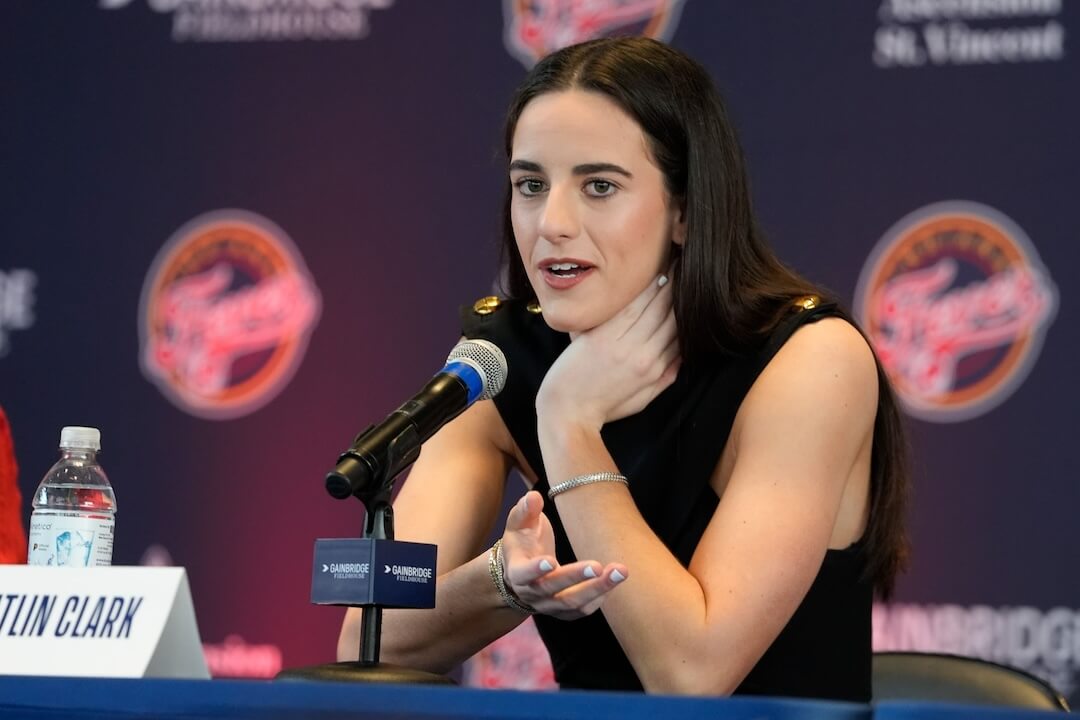
These clearly are “independent” news publishers, but they aren’t local news publishers. In my research, I’ve found that a large number of nonprofit news organizations who are members of the Institute for Nonprofit News and other similar organizations are focused on niche subjects and/or issues, not on covering what’s going on in a particular city or county. This does nothing to address the “news desert” that just keeps on growing. Knight and others should fund real local news.